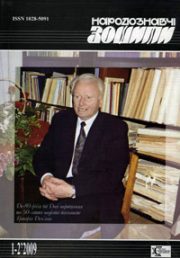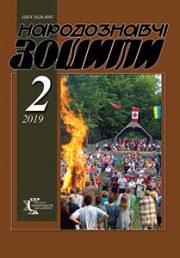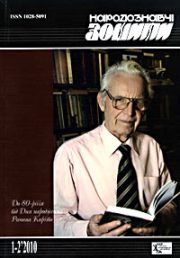The Ethnology Notebooks. 2022. № 4 (166), 938—943
UDK 75.038.6(477) “1987/1991”
DOI https://doi.org/10.15407/nz2022.04.938
THE MAIN ARTISTIC FEATURES OF THE UKRAINIAN TRANSAVANTGARDE IN 1987—1991
SALATYUK Larysa
- ORCID ID: https://orcid.org/0000-0002-9398-8243
- Postgraduate student of the Lviv National Academy of Arts,
- 38, Kubiiovycha Street, 79011, Lviv, Ukraine
- Contacts: e-mail: larasalatyuk@gmail.com
Abstract. The purpose of the article is to identify the characteristics of the Ukrainian transavantgarde. The object of the research is the works of transavantgarde artists. The subject of research is the artistic features of these works.
The relevance of the study lies in the need to identify artistic features that distinguish the Ukrainian transavantgarde from the original Italian. The chronology of the study covers the period from 1987 to 1991, which is the period of the emergence of the transavantgarde in Ukraine, and its active development. The methodological basis of the study are methods of comparative, stylistic and artistic analysis, iconographic method.
The main objectives of the study is to analyze the work of Italian and Ukrainian transavantgarde artists; identify common features and differences between the Italian and Ukrainian transavant-garde; to identify the characteristic features of the Ukrainian transavantgarde.
Keywords: Italian transavantgarde, Ukrainian transavantgarde, artistic features, painting, «new wave», «Parkomuna».
Received 11.08.2022
REFERENCES
- Olivia, A. (1979). La Trans-avanguardia italiana. Flash Art. Retrieved from: http://www.flashartonline.it/article/la-trans-avanguardia [in Italian].
- Burlaka, V. (2014). Alexander Hnylitskyi. Early works. Catastrophe of the gaze. Art Ukraine. Retrieved from: http://artukraine.com.ua/a/aleksandr-gnilickiy-rannie-raboty-katastrofa-vzglyada/#.VwNKQvmLTIV [in Russian].
- Burlaka, V. (2006). Ukrainian trans-avant-garde and new figurativeness — the experience of retrospective reflections. Art Studies of Ukraine: coll. of science pr. (Issue 6—7, pp. 61—75). Kyiv [in Ukrainian].
- Sklyarenko, G. (2009). New wave and Ukrainian art of the end of the 20th. (Issue 6, pp. 188—195). Kyiv [in Ukrainian].
- Sklyarenko, H. (2018). Modern art of Ukraine. Portraits of artists. IPSM NAMU. Kyiv: Huss [in Ukrainian].
- Lozhkina, A. Wonderful ten Odessa artists in «HudPromo». Retrieved from: https://hudpromo.livejournal.com/2837.html [in Ukrainian].
- Soloviev, A. (1999). Art of Ukraine in the 90’s (Reflections). Art magazine, 28—29. Retrieved from: http://www.guelman.ru/xz/362/xx28/x28015.htm (Last accessed: 16.06.2022) [in Russian].
- Sidor-Gibelinda, O. (1995). Obituary of the «Commune». Terra incognita, 3/4, 24 [in Russian].
- Akinsha, K. (1999). Wreath on the grave of Ukrainian postmodernism. Portfolio. The art of Odessa in the 1990s. (Pp. 12—15). Odesa [in Russian].
- Oliva, A.B. (1980). Italian Transavantgarde. Milan: Politi Edi tor [in Italian].
- Oliva, A.B. (2003). Art at the end of the second millennium. Moscow [in Russian].
- Kochubinskaya, T. (2018). Parkomuna. Place. Community. Phenomenon. Kyiv: Publish Pro [in Ukrainian].
- Oliva, A. (1996). Cultural nomadism and diaspora. Lecture. Kyiv: CSMS [in Ukrainian]
- Utevskaya, K. Transavangard. Retrieved from: http://www.ko rydor.in.ua/ua/glossary/doslidnytska-platforma-transavangard.html#_ftn10 (Last accessed: 16.06.2022) [in Russian].







